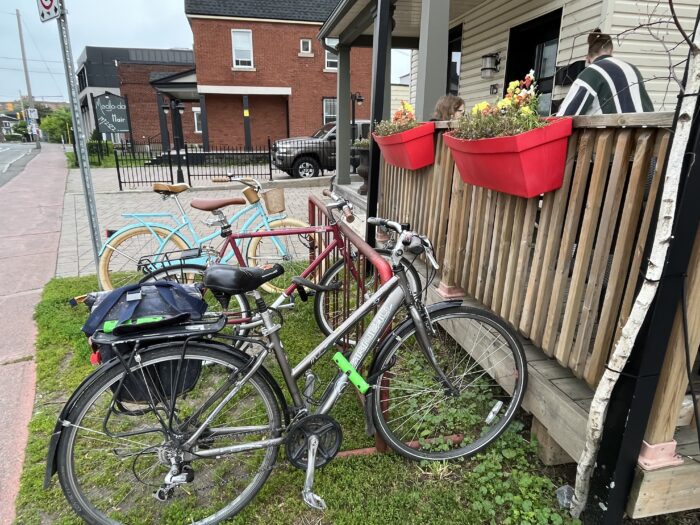In the midst of the hottest summer on record, with unprecedented forest fires clouding summer skies over Ottawa and dire climate news piling up on our already overwhelmed consciousness, not to mention the crises of the LRT shutdown and the affordable housing shortage, Mayor Mark Sutcliffe took time to publicly oppose closing Queen Elizabeth Driveway to cars to permit its use for sustainable modes of transportation like cycling and walking. (Another Bike Ottawa member dealt with many of the problems in the mayor’s statements in another piece.)
The mayor’s near-sightedness on active transportation infrastructure is not just frustrating for the rapidly growing numbers of citizens who need safe infrastructure to walk and roll around the city car-free, it’s also missing a significant opportunity for economic growth.
The lowly bike facility – let alone dedicated active transit corridors like the QED – has outsized economic impacts. Bike infrastructure increases retail spending in the area it’s built in, both through the greater spending power of consumers who are saving the average $11,000 annual expenditures on car ownership, and through the convenience of stopping easily at eye-catching stores or cafes without needing to search for parking or navigate traffic. Many people assume that reducing convenience for car ownership has a negative economic impact on businesses. A 2015 study of Queen Street West in Toronto’s Parkdale neighbourhood found that half of the local business owners estimated that more than 25% of their customers arrived by car. In fact, only 4% arrived by car, while 72% walked or cycled to the shop. Closing central Madrid to cars in 2018 resulted in a 9.5% boost to retail spending. The Canadian federal government’s National Active Transportation Strategy, a $400M investment in active transit routes, notes that active transportation infrastructure increases customer visits and spending intention by 48%.
Anyone who likes to check out retail properties (everyone, don’t lie) is familiar with the relationship between property values and active transit. An analysis of walk score ratings finds that families and businesses pay 35–45% higher prices for homes and commercial building space in the most walkable and active-transit accessible neighbourhoods. Glebe residents pay a premium to live in an area that is desirable precisely because it is accessible via walking and cycling. A 2009 U.S. nationwide study by CEOs for Cities, a cross-sector organization that develops ideas to make U.S. cities more economically successful, found that “houses located in areas with above-average walkability or bikeability are worth up to $34,000 more than similar houses in areas with average walkability levels.” This is most assuredly far higher now.
Then there are the less direct, but no less significant benefits: the public health outcomes. Mayor Sutcliffe loves to mention that he jogs, so is clearly well versed in the mental and physical benefits of regular activity, even if he does not see its connection to transportation. Those people who engage in regular active transit – even occasional errands – reap the well-documented physical and mental health benefits of greater physical activity. The U.S. Center for Disease Control’s Healthy People 2020 program includes specific objectives to increase walking and bicycling. A commonly-cited reason for not engaging in cycling as a form of transportation is fear of being hit by a car. A 2023 study from Australia noted that the three or four top reasons for not cycling were directly related to fears about being hit by a car. With safe routes for active transit, even those who are not particularly enthused about exercise are encouraged to engage in daily activity as part of their daily commute or in running errands.
Better population health has massive economic implications (just ask post-pandemic forecasters). A 2011 study of Portland, Oregon’s 40-year $138–605 million bicycle facility investments concluded that it was responsible for $388–594 million in healthcare savings and $7–12 billion in longevity value (people simply living longer) – and that was along with the along with $143–218 million in fuel savings that would result. Another 2011 study estimated changes in health benefits and monetary costs if 50% of short trips were made by bicycle during summer months in typical Midwestern U.S. communities – a fair approximation of Canadian circumstances. Across the area of study, the combined benefits of improved air quality and physical fitness are estimated to exceed $7 billion/year.
And of course, there are the emissions. As I wrote this, there was a massive hailstorm outside my window in late July in Ottawa. I am not alone in feeling as if I am on the precipice of a truly horrendous shift in the world we have known up to now. Climate change is projected to cost us hundreds of billions in lost productivity and necessary adaptations. In a report on the health costs of climate change, the Canadian Climate Institute estimates that towards the end of the century ground-level ozone could cause over a quarter of a million people per decade to be hospitalized or die prematurely, with an annual cost of $250 billion. Every small action we can do to reduce the pace and scale of our warming will save us some of these costs.
Mark Sutcliffe has children, and I assume he hopes to have grandchildren. As mayor of a mid-sized first-world city, he wields an unusual degree of power to impact our future. It is disappointing that he has so far failed to act upon this opportunity.
Nicky Cameron is a member of Bike Ottawa.

